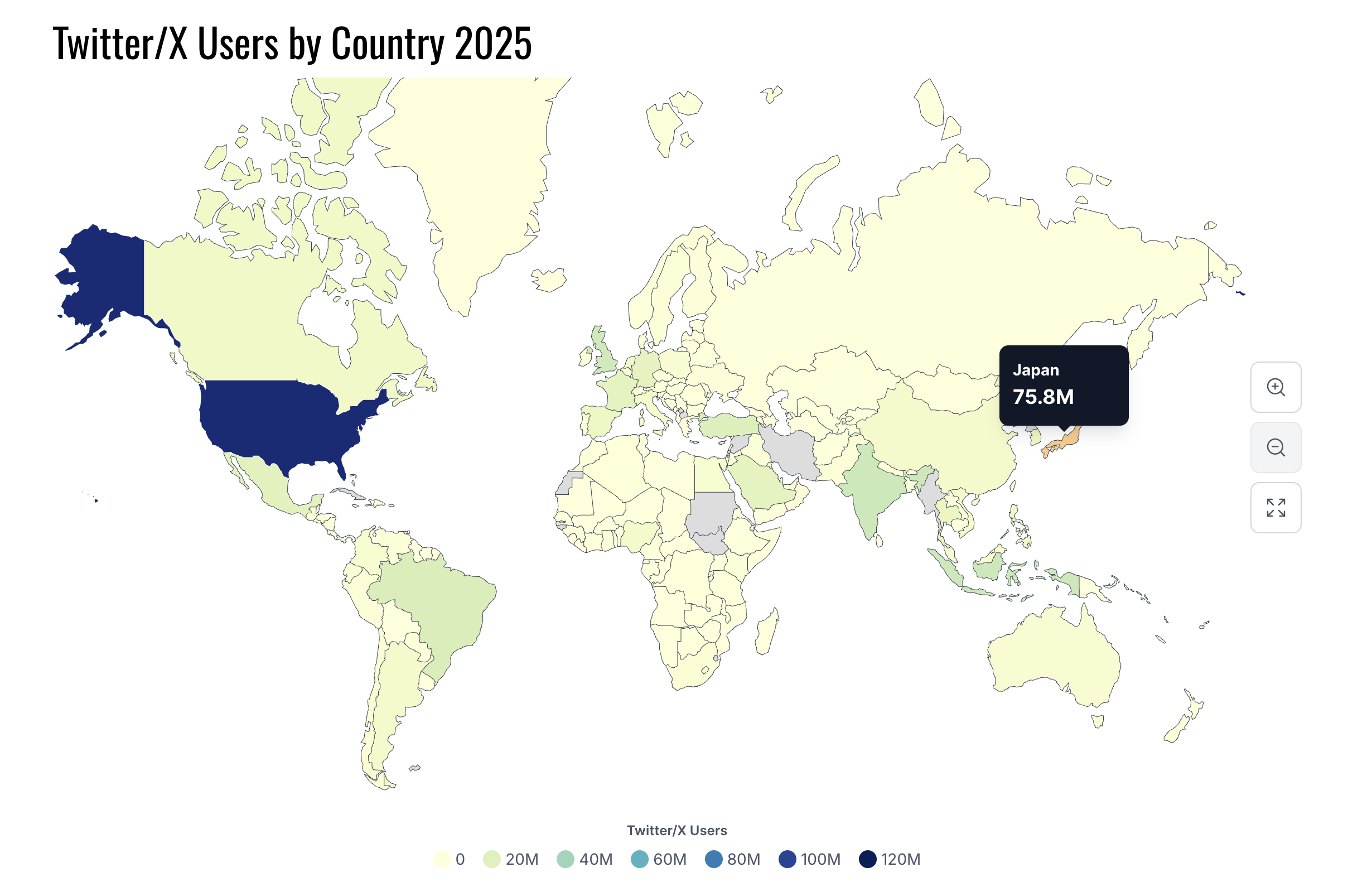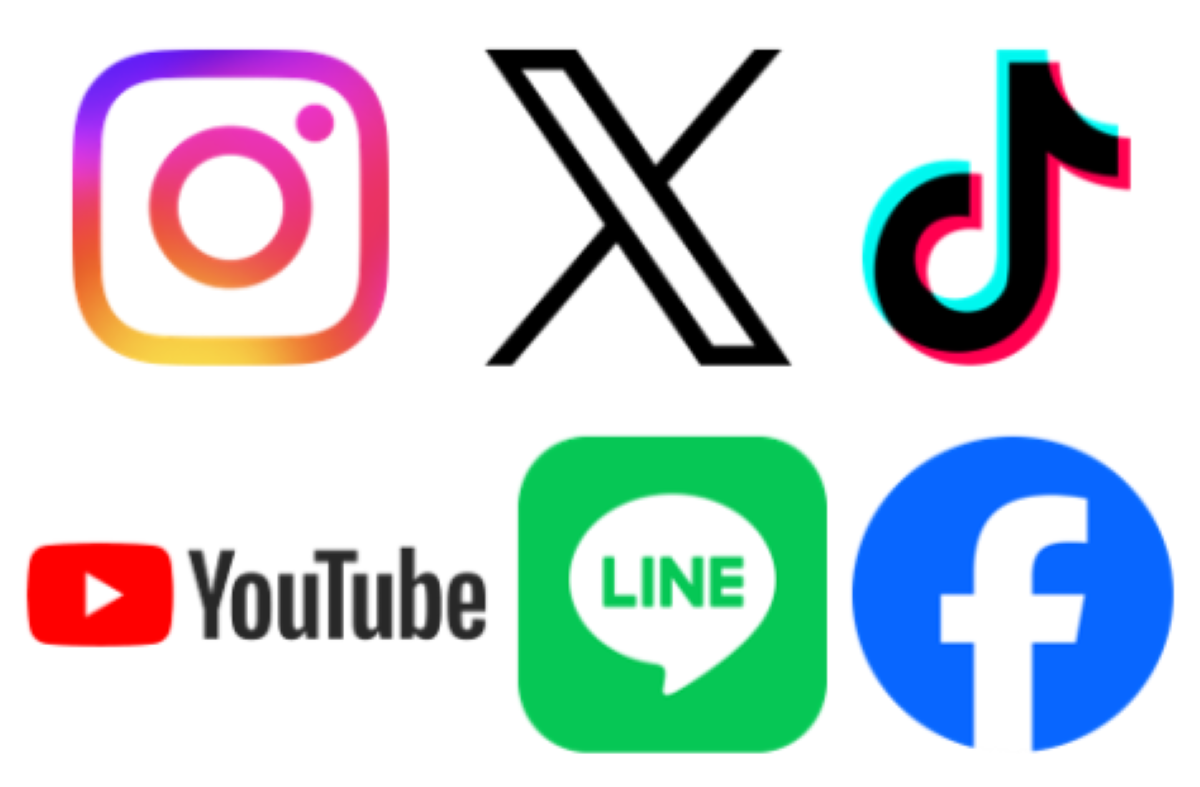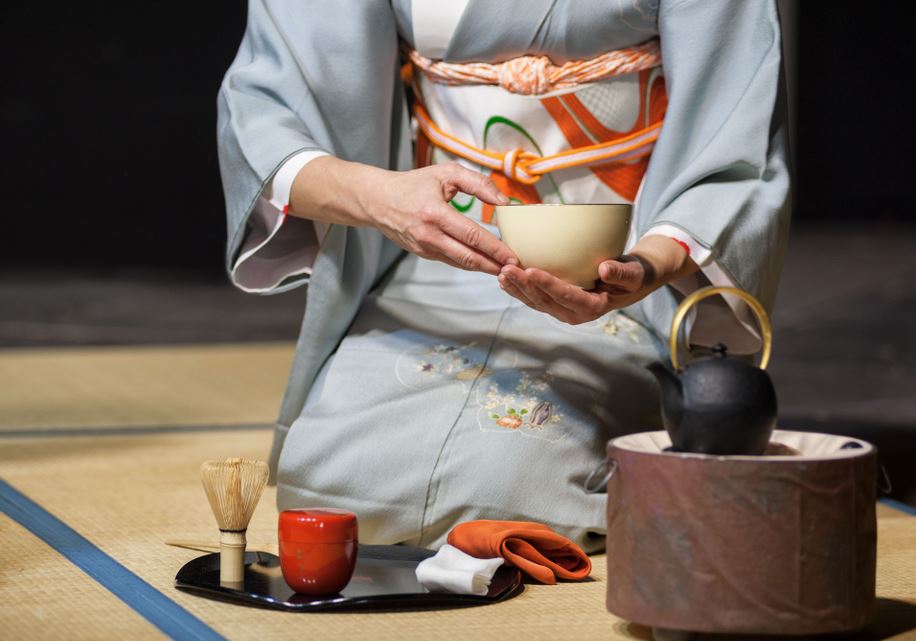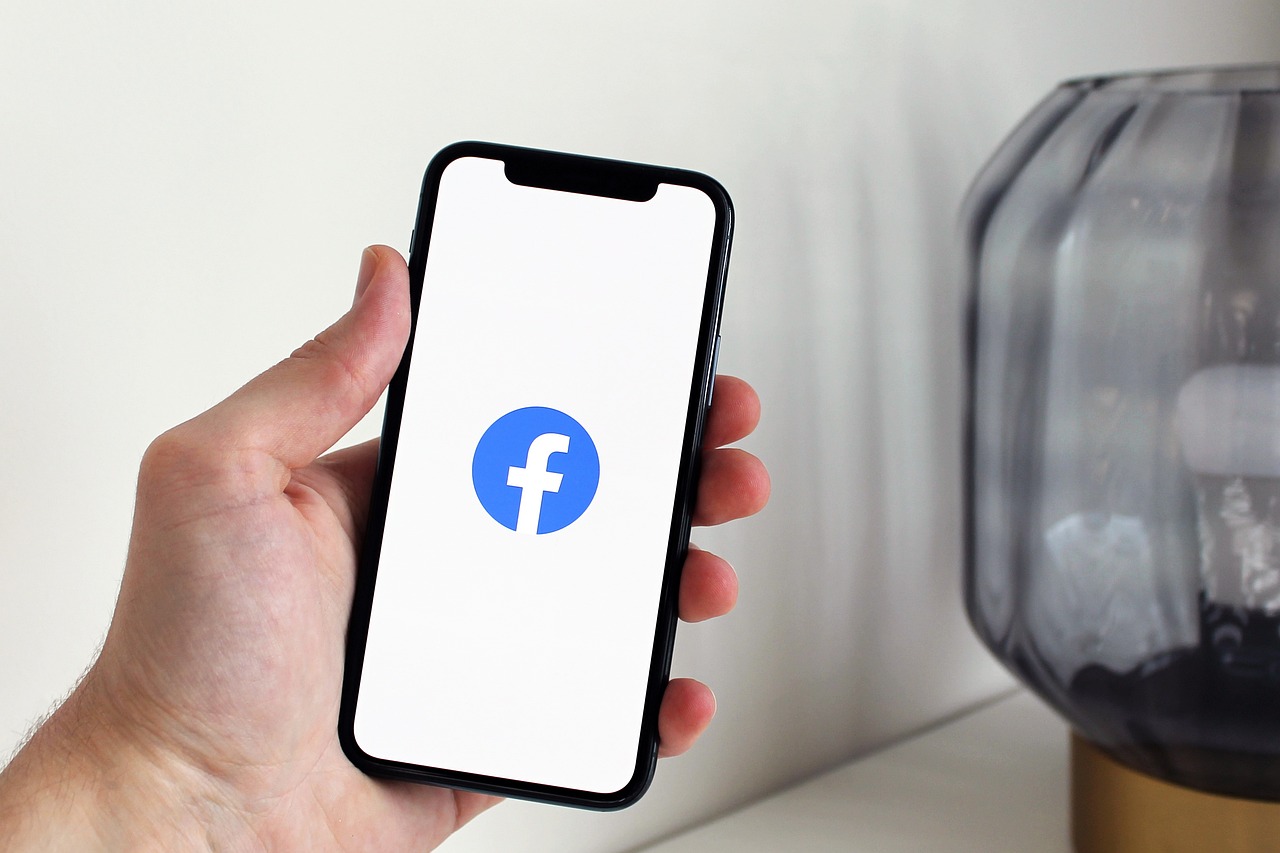.png)
Monthly active Twitter users in the world range between 415 million and 611 million depending on your preferred calculating methodology. Admittedly, this sounds like a modest number compared to Facebook's
3 billion monthly active users worldwide.
But in Japan? The hierarchy flips completely.
X (formerly Twitter) commands 48.65% of Japan's social media referral traffic while Facebook limps along at just 16.4%.
More striking: Japan is the second-largest X market globally with 75.8 million users in 2025,
while Facebook has only 26 million Japanese users.

This isn't just a preference. It's a fundamental cultural difference that Western brands consistently misunderstand—and it costs them millions in failed market entry attempts.
I learned this firsthand in 2022. With just 500 X followers posting about tech tools and no-code platforms,
I received multiple job offers and contractor requests daily from minor to major Japanese companies.
My Facebook posts during the same period? Complete silence.
This experience isn't unique. It's how the entire Japanese professional ecosystem operates.
In this article, you'll discover why X dominates Japan's social landscape, the cultural factors that make Facebook fundamentally incompatible with Japanese communication norms, and the exact strategies
Western brands need to succeed on Japanese X.
The Numbers Don't Lie: Japan's Inverted Social Media Hierarchy

Let's start with the hard data that most Western marketers miss.
X/Twitter in Japan (2025):
- 75.8 million users (2nd largest market globally, only behind the US)
- 49% overall penetration rate
- 82% of people in their 20s use X
- 211.1 app opens per month (the highest of any country in the world)
- 48.65% of all social media referral traffic
Facebook in Japan (2025):
- 26 million users
- Approximately 30% penetration rate (and declining year-over-year)
- Only 16.4% of social media referral traffic
- Strongest demographic: 30-40 year olds with 44.4% penetration
- Used primarily for international connections, not domestic engagement
The comparison is stark. X has nearly 3x more users than Facebook in Japan and drives 3x more website traffic. But raw numbers only tell part of the story.
Here's what these statistics actually mean:
While Western markets see X as a secondary platform for news and political discourse, Japan uses it as THE primary platform for professional networking, customer service, brand discovery, and business relationships.
Facebook, with its emphasis on real identities and personal connections, never gained traction in a culture where professional discretion and separation between public and private personas are paramount.
Why Facebook Failed in Japan:
The Real Name Problem

Facebook's fundamental feature , requiring real names , became its fatal flaw in the Japanese market.
To understand why, you need to grasp a core Japanese cultural principle:
"沈黙は美徳" (pronounced "chinmoku wa bitoku"), which translates to "silence is a virtue."
In Japanese professional culture, openly expressing opinions especially criticism or contrarian views is considered socially risky. You don't publicly disagree with colleagues, criticize industry practices, or share strong opinions about competitive products when your real name is attached.
Facebook's entire model requires exactly what Japanese culture discourages:
public identity tied to public opinions.
X, by contrast, thrives on pseudonymity. Over 70% of Japanese X users operate under anonymous or pseudonymous accounts. Scroll through Japanese X and you'll see what I mean: anime profile pictures everywhere, no personal photos, usernames that reveal nothing about real identity.

This anonymity creates something powerful: freedom to be honest.
The Pseudonymity Advantage

When looking across X accounts, it’s clear that many users choose pseudonymous handles.
This level of anonymity offers several advantages:
- It enables people to share honest opinions.
- It allows individuals to discuss workplace challenges without risking their professional reputation.
- It encourages authentic engagement with brands without fear of social judgment from peers.
Because of this freedom, users can be judged based on the value of their ideas rather than their identity.
Recruiters and companies often respond to genuine expertise and thoughtful commentary, regardless of whether a real name is attached.
This also shapes how Japanese consumers interact with brands.
On X, people tend to be more honest, more willing to provide feedback, and more open to real conversations. ( This can sometimes spark controversy tho)
On Facebook, they are typically more guarded, formal, and less engaged with brand content.
The Facebook Demographic Reality
The Japanese users who DO use Facebook fall into specific categories:
- Professionals with international business connections
- People maintaining relationships with overseas friends
- Older demographics (30-50s) who adopted it early
- Private group communications
What Facebook is NOT used for in Japan:
- Brand discovery
- Customer service
- Professional networking (despite LinkedIn's attempts)
- Engaging with company content
- Product research or recommendations
Facebook became the platform for maintaining existing international relationships,
not building new domestic ones. ( there is an exception too tho )
How X Became Japan's
Professional Networking Platform

While LinkedIn struggles with low adoption in Japan, X naturally evolved into the de facto professional networking space. Here's why it works.
Conversational Marketing vs. Broadcast Marketing
The biggest mistake Western brands make on Japanese X is treating it like a billboard. They post product announcements, ignore comments, push sales messages, and wonder why engagement flatlines.
Japanese brands take a radically different approach. They treat X like a conversation at an izakaya (Japanese pub)—casual, personal, and genuinely interactive.
.jpg)
Case Study: Sharp Japan's Human Voice
Sharp, the electronics manufacturer, exemplifies this perfectly.
In one viral tweet, their official account posted:
"こちとら電話や通話がイヤすぎてツイッターやってるんよ"
Translation: "I'm on Twitter precisely because I hate phone calls and talking."
This isn't corporate speak. It's one person talking to another person, admitting a relatable frustration.
The tweet resonated because it felt HUMAN, not like a press release from a multinational corporation.
Case Study: Kurasuhi Sushi's Co-Creation Strategy
Kurasuhi (くら寿司), a popular Japanese sushi chain, took a different approach.
They created "推しをおすしにできちゃう素材" (materials that let you turn your favorite character into sushi) and released them publicly on X.
Instead of controlling their brand message, they gave users tools to create parody content. The result?
Thousands of user-generated memes, massive organic reach, and genuine brand affinity—all from empowering their audience rather than broadcasting at them.
Case Study: Starbucks Japan's Japanese-First Approach
Even global brands adapt completely for Japanese X. Starbucks Japan's X account operates entirely in Japanese, with culturally-adapted content that feels local, not like translated corporate messaging from Seattle.
They tweet about seasonal Japanese flavors (sakura lattes, hojicha frappuccinos), respond to customer comments in casual Japanese, and participate in Japanese trending topics. Their tone matches Japanese communication style: polite but approachable, formal when needed but never stiff.
The lesson is clear: Japanese X is a place for dialogue, not monologue. Brands that succeed treat it like an ongoing conversation with friends, not a broadcast channel for marketing messages.
The Generational Sweet Spot

Understanding WHO uses X in Japan helps explain its dominance:
Age Demographics:
- Teens (13-19): Moderate usage
- 20s: 82% penetration (HIGHEST)
- 30s: High usage for professional content and networking
- 40s: Moderate but declining
- 50s+: Lower adoption
The 20-30 age group represents your core audience for most B2B and B2C brands entering Japan.
These are:
- Young professionals and decision-makers in Japanese companies
- Tech-savvy consumers with global awareness but Japanese cultural values
- Active researchers who use X for product discovery and brand evaluation
- The demographic most likely to engage with foreign brands
Even with just 500 followers focused on coding tools, I attracted job offers from major Japanese tech companies because recruiters actively scout X, not LinkedIn (which has far lower penetration in Japan).
This is where Japanese professionals live online.
The Real-Time Culture
Japanese X users expect immediacy. With 211.1 monthly app opens ,the highest in the world ,
Japanese users check X constantly throughout the day.
This creates specific expectations:
- Fast responses matter - Brands must respond to mentions within an hour, not days
- Trending topics are opportunities - Participating in relevant trends shows cultural awareness
- Mobile-first is non-negotiable - Desktop X is almost irrelevant in Japan
- Customer service happens publicly - Japanese consumers expect brands to address issues transparently on X
This real-time expectation aligns perfectly with Japanese business culture, where quick decision-making and responsive communication are valued.
Platform Strategy: Matching Purpose to Platform in Japan

Not all social platforms serve the same purpose in Japan.
Here's how to think about platform hierarchy:
X/Twitter - Best For:
- B2B lead generation and professional networking
- Real-time customer service (public responses build trust)
- Brand conversations and community building
- Thought leadership and industry insights
- Tech, SaaS, and professional services
- Trending topic participation and cultural relevance
My personal experience proves this. With minimal followers but consistent engagement, X generated legitimate business opportunities in ways no other platform could match.
Instagram - Best For:
- B2C visual products (fashion, beauty, food, lifestyle)
- Younger demographics (strong across age groups but especially teens-20s)
- Video content and Reels (Japan generates the most Stories content globally)
- Product showcases and visual storytelling
- E-commerce integration
Instagram works when your product is inherently visual and targets consumer purchases rather than B2B relationships.
Facebook - Best For:
- Older demographics (35-50)
- International community management
- Private groups for existing customers
- Expat and international audiences
- NOT for general Japanese consumer marketing
If your target market is Japanese consumers, Facebook should be your lowest priority.
LINE - The Essential Support Channel
Critical distinction: LINE is NOT a public platform like X or Instagram. It serves a completely different purpose.
LINE has over 95% penetration in Japan, but it's used AFTER you've generated leads through other channels.
Think of it as:
- Post-conversion nurturing - Where you communicate with customers who've already engaged
- Targeted messaging based on customer segments - Delivering personalized content based on behavior and preferences
- Customer service for existing clients - Private, detailed support conversations
- Exclusive offers and loyalty programs - Rewarding repeat customers
The workflow looks like this:
- Generate awareness and initial engagement on X or Instagram
- Convert interested prospects to LINE followers
- Nurture those relationships with targeted messages on LINE
- Drive repeat purchases and loyalty through LINE-exclusive content
LINE replaces what email marketing does in Western markets, but with dramatically higher open rates (65% vs 18-20% for email in Japan).
Actionable X/Twitter Strategy for Japan: What Actually Works

Let's get tactical. Here's exactly how to succeed on Japanese X.
Strategy #1: Japanese Language is Non-Negotiable

I'll be direct:
Japanese-only content performs exponentially better than English or bilingual posts on Japanese X.
Why this matters:
- X is a domestic platform in Japan, not an international one
- Users expect Japanese communication from brands targeting Japan
- Machine translation is immediately obvious and damages credibility
- Cultural nuances, humor, and tone require native Japanese fluency
Even global giants like Starbucks, Apple, and Microsoft tweet exclusively in Japanese on their Japan accounts. This isn't optional—it's table stakes.
Action steps:
- Hire native Japanese content creators, not just translators
- Understand Japanese X slang, memes, and trending formats
- Use appropriate keigo (politeness levels) based on your brand positioning
- Never rely on Google Translate or English-first thinking
Strategy #2: Embrace Conversational, Human Tone
Remember this Sharp example? That's your model.
What this looks like in practice:
❌ Corporate speak:
"We are pleased to announce our new product launch and appreciate your continued support."
✅ Human voice:
"新製品やっと出せた😭開発チーム死にそうだったけど最高の仕上がりになった!"
(Finally launched the new product 😭 The dev team almost died but it turned out amazing!)
The difference is authenticity.
Japanese X users can smell corporate-speak instantly, and they scroll right past it.
Strategy #3: Timing and Frequency Matter
Japanese X has distinct usage patterns:
Peak engagement times:
- Morning commute: 7-9 AM
- Lunch break: 12-1 PM
- Evening: 8-11 PM
Posting strategy:
- Minimum 3-5 tweets per day
- Respond to ALL mentions within 1 hour
- Participate carefully in trending hashtags (avoid controversial topics)
- Use polls and questions to drive two-way conversation
Consistency matters more than perfection. Daily presence signals commitment to the Japanese market.
Strategy #4: Customer Service IS Marketing

In Japan, how you handle customer complaints publicly on X directly impacts brand perception.
The Japanese expectation:
- Public responses show transparency and accountability
- Problems solved publicly become trust-building moments
- Never delete negative comments—address them professionally
- Follow up publicly when issues are resolved
Example framework:
When a customer complains:
❌ Western approach: "Please DM us so we can help you privately."
✅ Japanese approach: "ご迷惑をおかけして誠に申し訳ございません。すぐに確認して改善いたします。"
(We sincerely apologize for the inconvenience. We will check immediately and improve this.)
Then publicly post an update when resolved. This transparency builds trust not just with the complaining customer, but with everyone watching the interaction.
Strategy #5: Content Types That Perform
Based on analysis of successful Japanese brand accounts:
High-performing content:
- Behind-the-scenes content - Japanese users love transparency and process
- User-generated content - Retweet customer posts and showcase community
- Trending topic commentary - Shows cultural awareness (but avoid politics)
- Helpful tips and how-tos - Position as resource, not just seller
- Self-deprecating humor - Humility resonates in Japanese culture
Low-performing content:
- Purely promotional posts without context or value
- English-language content (unless targeting expats specifically)
- Posts that ignore replies and comments
- Excessive corporate jargon and formality
- Too many hashtags (1-2 maximum; Japanese X culture avoids hashtag spam)
Strategy #6: The Co-Creation Mindset
Remember this Kurasuhi's strategy of giving users tools to create their own content?
This works because it shifts from broadcast to participation.
How to implement:
- Create shareable assets (templates, graphics, memes)
- Encourage users to remix and share your content
- Amplify user creations (retweet, quote tweet with appreciation)
- Build community around shared creativity, not just consumption
This approach transforms customers into collaborators, creating authentic engagement that paid advertising can't replicate.
Common Mistakes Western Brands Make (And How to Avoid Them)

After watching countless Western brands struggle with Japanese X, these mistakes stand out:
Mistake #1: Treating X Like Facebook

Broadcasting product announcements, ignoring comments, and posting only when you have something to sell kills engagement instantly.
The fix: Make 80% of your content conversational and valuable, only 20% promotional.
Mistake #2: English Content
"Because It's International"
Even global brands tweet in Japanese when targeting the Japanese market. English content signals that you're not serious about Japan.
The fix: 100% Japanese content. No exceptions. Not even for "international" brands.
Mistake #3: Corporate Speak That Sounds Like Press Releases

Formal, stiff language alienates Japanese X users who expect personality and authenticity.
The fix: Study how Sharp, Kurasuhi, and other successful Japanese brands actually write.
Copy their tone, not their words.
Mistake #4: Inconsistent Presence
Posting once a week doesn't cut it. Japanese users expect daily engagement.
The fix: Commit to 3-5 posts daily minimum, with same-day responses to all mentions.
Mistake #5: Ignoring Customer Comments
Every mention is an opportunity. Ignored customers become vocal critics, and observers notice the silence.
The fix: Set a 1-hour response time goal for all customer mentions, whether positive or negative.
I've seen Western SaaS companies post in English, completely ignore Japanese replies, and genuinely wonder why they can't gain traction. Meanwhile, their Japanese competitors tweet 10x per day, respond within minutes, and build real relationships with customers.
The difference isn't budget. It's cultural understanding and commitment.
Measuring Success:
Metrics That Actually Matter

Forget vanity metrics. Here's what indicates real success on Japanese X:
Meaningful Metrics:
- Reply rate - Are people actively talking TO you, not just about you?
- Retweets with comments - Are people sharing your content with their own opinions added?
- Website click-through rate - Is engagement driving actual traffic?
- DM inquiries - The ultimate lead generation metric for Japanese B2B
- Customer service resolution - Are you solving problems publicly?
Less Important Metrics:
- Follower count alone (quality matters more than quantity)
- Impressions without engagement
- Likes without comments or shares
My personal benchmark proves this: with just 500 followers focused on tech content, I received multiple job offers from minor to major Japanese companies. Follower count mattered far less than engagement quality and demonstrated expertise through consistent conversation.
The Future of X in Japan

Several trends will shape Japanese X marketing in the coming years:
1. Video content expansion - Short-form video is growing rapidly on X Japan
2. E-commerce integration - X Shopping features are gaining traction
3. X Premium adoption - Growing among Japanese professionals for enhanced features
4. AI integration - How Grok and AI features affect Japanese user behavior
My prediction: X will continue dominating Facebook in Japan because it's fundamentally aligned with how Japanese professionals want to communicate—pseudonymous, conversational, real-time, and authentic.
Facebook will remain a niche platform for international connections and older demographics, but it will never challenge X's dominance in Japan.
For Western brands, this means X investment in Japan will only increase. Competition will intensify.
Early movers who understand the cultural dynamics will maintain significant advantages over deep-pocketed latecomers who try to buy their way in without cultural adaptation.
Your Next Steps:
Building X Success in Japan

The 48% vs 16% traffic share gap isn't just a statistic—it's a roadmap.
X is where Japanese professionals spend their time, share their opinions, and discover new brands.
Immediate Action Plan:
This Week:
- Audit your current X presence (or create one if you haven't)
- Analyze 10 successful Japanese brand accounts in your industry
- Identify native Japanese content creators or agencies to partner with
This Month:
- Create a Japanese-language content calendar with 3-5 posts daily
- Set up monitoring for all brand mentions (using tools like SocialDog)
- Establish a 1-hour response time goal for all customer interactions
Next 3 Months:
- Post consistently in conversational Japanese
- Engage authentically with trending topics (carefully)
- Respond to every mention, positive or negative
- Analyze what content formats drive the most meaningful engagement
- Double down on high-performing content types
The question isn't whether you should be on X in Japan.
It's whether you can afford not to be.
At Pont Miyabi, we help Western brands navigate Japanese social media with bicultural expertise.
Our team understands both markets—we know what works in the West and exactly why it needs to adapt for Japan. We've grown accounts from 0 to 40K followers across both Japanese and English markets, and we know the cultural nuances that make the difference between failure and success.
If you're planning to enter the Japanese market, or if you're struggling to gain traction despite being present on Japanese social platforms, we can help you build a strategy that actually works—one that respects Japanese communication culture while achieving your business goals.
Because in the end, success in Japan isn't about translation. It's about transformation.
—
Hayate Yoshizawa,
Co-Founder at Pont Miyabi🌏
🔗 Connect: LinkedIn | Website
📩contact@pontmiyabi.com
What's happening
Our latest news and trending topics



.webp)